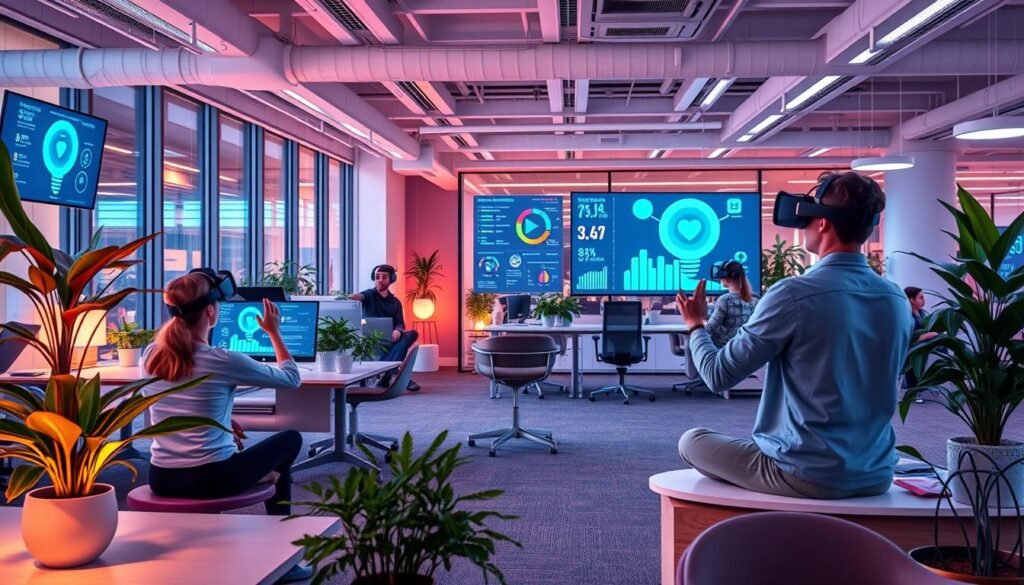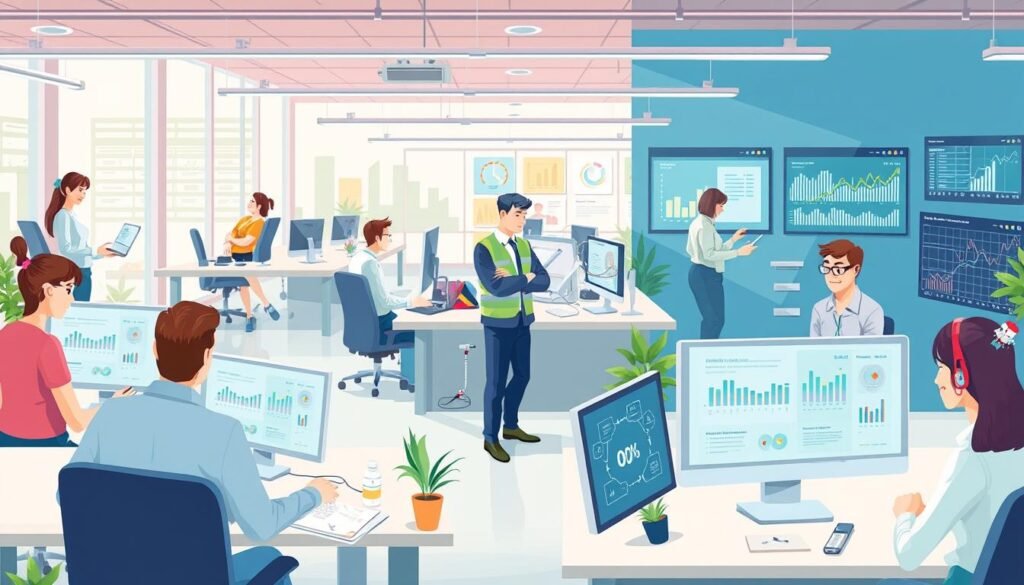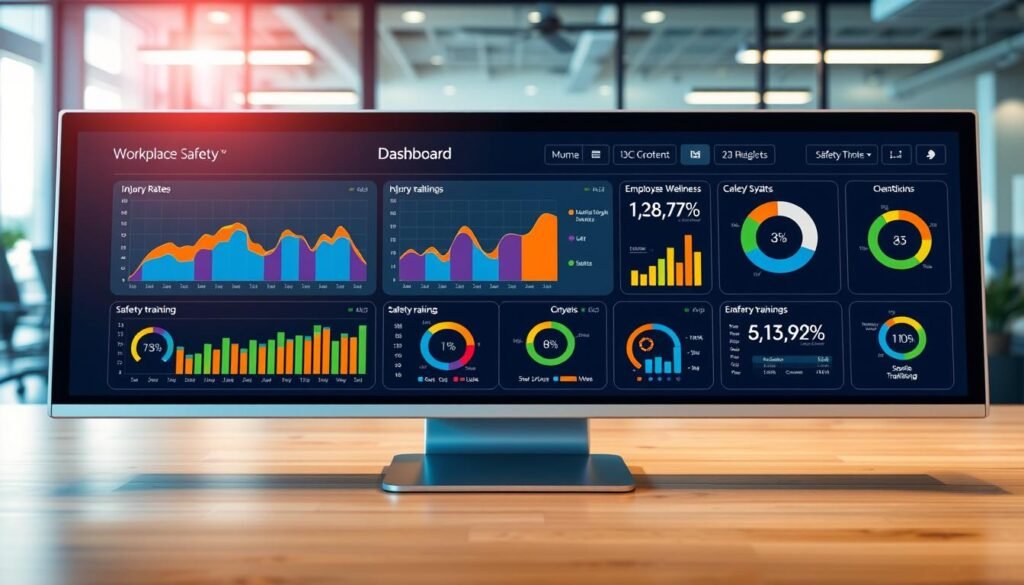The modern workplace is changing fast, and so is occupational health. New technologies and data strategies are leading this change. They make it more important than ever to focus on employee wellbeing and a safe work environment.
Thanks to digital innovations, employers can now meet their employees’ health needs better. This leads to better productivity, lower costs, and a happier, more engaged team.
This article looks at how new ways are changing occupational health services. It shows how technology and data are making it easier for companies to keep their workers safe and healthy. We’ll see how digital tools and smart technologies are helping employers build a better, more efficient workplace.
Key Takeaways
- Occupational health is undergoing a digital transformation, leveraging technology and data to enhance employee wellbeing.
- Employers are adopting innovative approaches to proactively address the healthcare needs of their workforce.
- Digital health monitoring systems and smart technologies are revolutionizing the way organizations manage employee health and safety.
- Data-driven strategies are enabling employers to create a healthier, more efficient, and more resilient workforce.
- Occupational health services are evolving to prioritize employee wellbeing, improve productivity, and reduce healthcare costs.
The Evolution of Modern Occupational Health Services
The world of occupational health services has changed a lot lately. Old ways of checking employee health are being replaced by new digital tools. These tools make things more efficient, personal, and give insights in real-time.
Traditional vs. Digital Health Monitoring Systems
Old occupational medicine used to rely on regular check-ups and paper records. Now, digital health monitoring systems use new tech for constant, detailed health checks. They track things like heart rate, sleep, stress, and activity levels.
Impact of Remote Work on Employee Health Management
Remote work has changed how we handle work-related injury care and employee health needs. Old occupational health services had to change. Now, many use virtual consultations, telemedicine, and remote monitoring for their teams.
Integration of Smart Health Technologies
Smart health technologies like wearables and apps have changed comprehensive occupational health programs. These tools help collect data in real-time, offer personal health tips, and help employees manage their health better.
| Traditional Occupational Health | Modern Digital Health Solutions |
|---|---|
| Periodic check-ups and manual data collection | Continuous, automated biometric monitoring |
| Paper-based records and manual data entry | Cloud-based digital health platforms |
| On-site occupational health services | Remote consultations and telemedicine |
| Limited employee engagement | Personalized health insights and interventions |
The shift in occupational health services has been huge. It’s all about using new tech and focusing more on employee health. As companies aim for safer, healthier workplaces, mixing old and new in occupational medicine will be key.
Digital Transformation in Workplace Wellness Programs

Organizations are now using digital technologies to change their wellness services. Occupational health clinics offer new services through digital platforms. This changes how employees use and get to health resources at work.
Digital health assessments are a big step forward. Employees can do online wellness checks. This gives health professionals the data they need to make wellness plans just for each person.
Virtual wellness coaching is also becoming more common. Workers can get help from wellness coaches online. This lets employees play a bigger role in their health.
Occupational health clinics also offer online health education. There’s lots of info on stress, nutrition, and more. This makes it easy for workers to learn about health and make good choices.
Digital wellness programs are making health better for employees. They use technology and data to offer better, more personal wellness services. This is great for the modern workforce.
| Traditional Wellness Programs | Digital Wellness Programs |
|---|---|
| In-person health screenings | Online health assessments |
| Periodic wellness workshops | Virtual wellness coaching |
| Printed health education materials | Interactive digital resources |
| Limited employee engagement | Increased employee engagement |
“The digital transformation of workplace wellness programs is empowering employees to take a more active role in managing their health and well-being.”
As occupational health clinics keep growing, digital tech will be key. It will help improve wellness services, workplace health, and occupational health for today’s workers.
Advanced Data Analytics for Employee Health Monitoring

The world of work health is changing fast. Advanced data analytics is leading the way in keeping employees safe and healthy. It uses predictive tools and real-time health checks to help prevent injuries and improve work conditions.
Predictive Analytics in Injury Prevention
Predictive analytics looks at past data and uses smart algorithms to spot risks. It helps find out who might get hurt on the job. This way, companies can take steps to prevent injuries and keep workers healthy.
Real-time Health Risk Assessment Tools
New tech like wearables and sensors lets us watch employee health as it happens. These tools catch early signs of problems. This means workers get help fast, keeping everyone safe and productive.
Performance Metrics and Health Outcomes
Good metrics are key to knowing if health programs work. By tracking things like injury rates and how often people miss work, companies can see what’s working. This helps them make their health programs even better.
“The integration of advanced data analytics in occupational health is a game-changer, empowering employers to proactively address employee well-being and create safer, more productive work environments.”
Occupational Health: Emerging Technologies and Solutions

In the field of occupational health, new technologies are changing how occupational health professionals help employees. They use virtual reality (VR) for safety training and telemedicine for health checks. These tools help board certified in occupational and certified in occupational and environmental medicine experts give better care to workers.
Virtual reality is making safety training better. It lets workers practice in safe, real-like settings. This way, they learn and remember safety rules better, making workplaces safer.
Telemedicine is also changing how health care is given. It lets occupational health professionals talk to workers remotely. They can do virtual health checks and make plans for care, even when workers are far away.
Blockchain is making health data safer. It helps keep employee health info private and secure. This makes sure health data is safe and meets new rules, building trust with workers.
“The future of occupational health is digital, data-driven, and highly personalized. By embracing these emerging technologies, we can empower employees to take a more active role in their wellbeing while providing occupational health professionals with the tools they need to deliver exceptional, evidence-based care.”
New technologies are key to bettering employee health and safety. They help make workplaces safer and improve health care for workers.
Mobile Health Applications and Wearable Devices in the Workplace

Mobile health apps and wearable devices are changing how we look at work health. They help occupational health providers, physician assistants, and nurse practitioners give better care. This care is more tailored, timely, and effective.
Smart PPE and Safety Monitoring
Smart personal protective equipment (PPE) is making workplaces safer. It includes smart hard hats, safety vests, and gloves. These items track vital signs and alert urgent care or immediate care if needed.
Remote Health Tracking Systems
Wearable devices track health metrics like activity and sleep. They send data to occupational health providers. This helps catch health issues early and prevent bigger problems.
Integration with Occupational Medicine Services
Mobile health apps and wearable devices work well with traditional health services. They give physician assistants and nurse practitioners real-time data. This helps employers keep their workers healthy and happy.
| Technology | Key Features | Benefits |
|---|---|---|
| Smart PPE |
|
|
| Remote Health Tracking |
|
|
“The integration of mobile health technologies with occupational medicine services is transforming the way we approach employee healthcare, empowering us to provide more personalized, proactive, and data-driven solutions.”
– Dr. Sarah Johnson, Occupational Health Specialist
Artificial Intelligence in Employee Health Management

We see how artificial intelligence (AI) can change workplace safety and employee wellbeing. AI is making a big difference in how companies manage employee health. It helps them be more proactive and give care that fits each person’s needs.
AI is especially useful with health chatbots. These chatbots talk to employees, giving health tips, setting up appointments, and checking health. This lets the health team do more important work, helping everyone more.
AI also helps predict injuries before they happen. It looks at lots of data to find patterns that show where health risks might be. This helps companies take steps to keep their workers safe.
Wearable devices and smart sensors add to the team’s abilities. They track health data in real time. This means the team can act fast if something looks off, keeping the workplace safer and healthier.
“The integration of artificial intelligence in employee health management is a game-changer, enabling us to provide more personalized, proactive, and effective care for our workforce.”
AI will be key in the future of keeping workers healthy and safe. It lets companies give better care and build a culture of health and safety. This is good for everyone in the workplace.
Building a Technology-Driven Workplace Safety Culture

In today’s world, employers and employees must team up to make safety a top priority. Technology helps make workplaces safer and more efficient. It makes it easier to stay safe and work well.
Employee Engagement Through Digital Platforms
Getting employees involved in safety is key. Digital tools like apps and portals offer a place for safety info and training. They help workers feel they’re part of keeping the workplace safe.
Data-Driven Safety Training Programs
Good safety training is essential. Technology lets us create training that really works. With data, we can focus on the right safety issues and see how well our training is working.
Measuring Safety Performance Metrics
To get better at safety, we need to track our progress. Digital tools help us see how we’re doing. This way, we can spot where we need to get better and make smart choices to improve safety.
| Metric | Description | Benchmark |
|---|---|---|
| Total Recordable Incident Rate (TRIR) | Measures the number of recordable injuries and illnesses per 100 full-time workers. | 3.0 or less |
| Lost Time Injury Frequency Rate (LTIFR) | Tracks the number of work-related injuries that result in lost work time. | 1.0 or less |
| Safety Training Completion Rate | Monitors the percentage of employees who have completed required safety training programs. | 95% or higher |
Using technology, we can create a safety culture that empowers everyone. It makes training better and gives us the data we need to keep getting safer.
Also Read : Understanding Medical Procedures: What To Expect Before, During, And After
Conclusion
The digital change in occupational health services has changed how companies care for their workers. Technology and data help employers find new ways to keep their teams healthy and productive. Tools like smart health devices and injury prevention software make health care more proactive and tailored.
With more people working from home or in hybrid setups, using digital health tools is key. Employers need to make sure workers can stay healthy and safe, no matter where they are. This helps create a safe and supportive work environment, boosting productivity and success.
Unlocking the best in occupational health requires combining the latest tech with data-driven plans. By doing this, companies can build a strong, safe, and healthy team. As health care technology advances, forward-thinking businesses will lead the way in creating better workplaces.
FAQs
Q: What are Occupational Health Services?
A: Occupational Health Services encompass a range of services designed to improve the health of your employees and ensure workplace safety. These include injury care, wellness services, pre-employment evaluations, and ongoing health assessments.
Q: How can a clinic help with work-related injury care?
A: A clinic specializing in occupational health can provide comprehensive work-related injury care, including assessment, treatment, and rehabilitation, helping employees to return to work safely and effectively.
Q: What types of physical exams are included in occupational health services?
A: Occupational health services include various physical exams such as pre-employment physicals, pre-placement assessments, and regular health check-ups to monitor the overall health of your employees.
Q: How do employers benefit from using occupational health clinics?
A: Employers benefit from occupational health clinics by ensuring compliance with regulations, reducing workplace injuries, improving productivity, and supporting the overall wellness of their workforce.
Q: What is the role of occupational health professionals?
A: Occupational health professionals assess the health needs of employees, provide treatment for work-related injuries and illnesses, and develop programs to promote wellness and prevent future injuries.
Q: What services are provided for return-to-work programs?
A: Return-to-work programs may include assessments to determine an employee’s fitness for duty, rehabilitation support, and coordination with healthcare providers to facilitate a smooth transition back into the workplace.
Q: Are wellness services part of occupational health services?
A: Yes, wellness services are a critical component of occupational health services and may include programs focused on stress management, nutrition, fitness, and preventive care to enhance employee health and productivity.
Q: How do occupational health services address the specific needs of an organization?
A: Occupational health services can be tailored to meet the specific needs of an organization by providing customized programs and interventions that align with the unique workforce health challenges and industry regulations.
Q: What best practices should employers follow to maintain workplace safety?
A: Employers should follow best practices such as conducting regular health assessments, providing training on workplace safety, implementing wellness programs, and collaborating with occupational health professionals to address health and safety concerns.
Q: How can I contact you to learn more about your occupational health services?
A: To learn more about our comprehensive occupational health services, please contact us through our website or call our office directly for more information and to discuss your specific occupational health needs.









